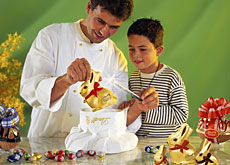Luxury chocolate sales boom at Christmas

Swiss chocolate makers were reporting brisk trade in the run-up to Christmas, with many customers opting for top-end of the range products.
Dark chocolate and special holiday recipe chocolates are particularly popular. However, not all countries that enjoy Swiss chocolate show the same tastes and trends.
“Sales are going well. Champagne truffles are very popular, as well as our Christmas packages, which we decorate ourselves,” Madeleine Rubio-Teuscher, of the Zurich-based traditional chocolate makers Teuscher, told swissinfo in the week before Christmas.
A glance around her shop – a festive treasure trove – confirms that it is doing lively business. “I’ve bought champagne truffles. They’re famous from this shop,” admits one local woman.
“I’ve bought marrons glacés [candied chestnuts] and griottes [chocolates with cherry liqueur],” says another. “I’ve bought them for myself – one has to be selfish sometimes!”
Teuscher is typical of Swiss chocolate companies in that it also has an international clientele. It sends packages around the world and attracts many tourists to its shops across Zurich.
“I’m buying for myself and gifts,” says a young South Korean woman. “I read about Swiss chocolate in my guidebook.”
Larger Swiss chocolate companies, such as Lindt & Sprüngli and Chocolat Frey, as well as retailers Globus, Migros and Coop, also say they are doing well – although final sales statistics are not available yet.
Christmas expectations
This follows on from figures released earlier this month predicting that Swiss retail sales would climb in the holiday run-up. Those for October have already risen by 6.6 per cent, the highest rise since June 2001.
Sylvia Kälin from Lindt & Sprüngli says Christmas is the most important time for the premium chocolate maker.
“[Trends are] very gifty, with elegant packaging, as well as products with special recipes that are adapted to Christmas… cosy recipes with caramel, nuts and spices, like Christmas cookies,” Kälin told swissinfo.
Dark chocolate is an overall trend. Also doing well were traditional hollow figures of Father Christmas, snowmen and the recent addition – the reindeer.
But Kälin said that different countries showed different preferences. The hollow figures are more popular in Britain, the United States and Germany, where these characters are more traditional.
Mediterranean countries tended to go for big, showy boxes of chocolates.
US tastes
The United States in particular has different tastes. Lindor balls are popular during the Yuletide, but not in the flavours known in Europe – mint, strawberry and even peanut butter are all favourites across the Atlantic.
Chocolat Frey, which belongs to Migros and is a leader in the Swiss chocolate market, also reported that premium brands were selling well, especially chocolates already packaged as Christmas gifts.
“We can see that particularly abroad there is a clear tend towards so-called ‘special flavours’. In Switzerland the trend towards dark chocolate has been accented,” Chocolat Frey spokesman Christoph Schmassmann told swissinfo.
Chocolat Frey has just launched a range in the US, where holiday flavours include gingerbread, winter fruit and nut, as well as cinnamon coriander.
Dark chocolate with a high cocoa content has long been long flagged-up by industry watchers, who have pointed to its more healthy image and the fact that chocolate can be differentiated by using different beans, rather like coffee.
Overall, analysts say that high-end chocolate – dark, milk or white – is likely to develop into a long-term trend and to be considered a luxury product on a par with a good bottle of wine.
swissinfo, Isobel Leybold-Johnson in Zurich
According to Chocosuisse, the umbrella group of Swiss chocolate manufacturers, “Swiss chocolate” is a completely conched chocolate or chocolate mixture made of cocoa beans, cocoa mixture, cocoa butter, sugar and in some cases milk, manufactured entirely in Switzerland.
In Switzerland – as well as in the EU and other countries – there are strict regulations governing chocolate. Since 1995 chocolate in Switzerland may contain up to 5% by weight of vegetable fat other than cocoa butter.
However, the prescribed minimum cocoa content must still be maintained. Swiss manufacturers are not yet taking advantage of this move, introduced to adapt Swiss regulations to those of the EU.
The share of milk chocolate of total chocolate consumed in Switzerland: milk chocolate, 75%; dark chocolate, 20%; white chocolate, 4-5%.
There is currently a growing trend towards dark chocolate, say manufacturers.
Around 90,134 tonnes of chocolate products (including imports but excluding cocoa and chocolate powder) were consumed in Switzerland in 2006.
Switzerland has an average per capita consumption of 11.9kg, ranking it first among the consumer countries.
But this figure also includes the purchases of tourists and those who drive over the border just to buy Swiss chocolate.

In compliance with the JTI standards
More: SWI swissinfo.ch certified by the Journalism Trust Initiative











You can find an overview of ongoing debates with our journalists here . Please join us!
If you want to start a conversation about a topic raised in this article or want to report factual errors, email us at english@swissinfo.ch.